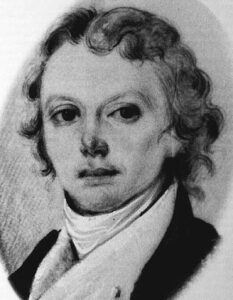
Thomas Walter—a photo from a miniture in possession of a direct descendant, Mrs. Benjamin Arthur Bolt of Greenville, in David Rembert’s book, Thomas Walter, Carolina Botanist.
Editor’s Note: At the request of his readers and in memory of Warner M. Montgomery, Ph. D, we will continue to publish his Adventure Travel stories for the time being.
Show me your cemeteries, and I will tell you what kind of people you have. —Benjamin Franklin Cemeteries are records of the past. Gravestones are expressions of love and affection engraved in history.
In Pineville, there are graves of three influential people from the past: Gen. Francis Marion, Col. Hezekiah Maham, and biologist Thomas Walter.
Thomas Walter, an English merchant, arrived in Charleston before 1769 and immediately began building his fortune in land and politics. During his life he owned 4,387 acres of farmland and was elected to the offices of county road commissioner and State House of Representatives.
Walter’s greatest contribution, however, was as a botanist. He rented (then later purchased) 500 acres of Mexico Plantation between the Porchers and the Marions where he built a home and a botanical garden. Using the system of Linnaeus, he collected and described over 1,000 native plants of the Santee.
John Fraser, the English plant collector, met Walter in 1786 and encouraged him to record his findings which he did as a manuscript called Flora Caroliniana. Fraser took the manuscript and many of Walter’s plants back to England in 1787. The manuscript was published in 1788. After Fraser’s death, the collection was purchased by the British Museum of Natural History in London and placed in the Walter Herbarium, named for Pineville’s Thomas Walter.
Carolina’s first botanist was married three times and had five children. He died in 1789 and left his three daughters 32 slaves, seven oxen, nine cows, 39 sheep, 19 hogs, 230 bushels of corn, 45 barrels of rice, and 2,700 bushels of rough rice. He was buried on his property overlooking the Santee River near the historic Santee Canal.
Walter’s daughters placed a marble marker over his grave 25 years after his death which reads, in part:
“At his desire he was buried in this spot, once the garden in which were cultivated most of the plants of his Flora Caroliniana.”
The grave was restored with a brick foundation and a wrought iron fence in 1931. (David H. Rembert. Thomas Walter, Carolina Botanist. Museum Bulletin Number 5, SC Museum Commission. 1980)
Thomas Walter’s grave is, today, at the end of a logging road that runs along the Old Santee Canal to the Santee River. The property is now owned by former S.C. Governor James Edwards and is not open to the public.





Leave a Reply